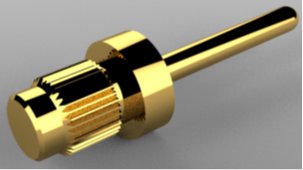 Continuing the discussion on screw machine technology, here is a look at this technology, the advantages of using it and how to best utilize this technology in your engineering projects. Below is a list of the common styles of press-fit screw machine header pins:
Continuing the discussion on screw machine technology, here is a look at this technology, the advantages of using it and how to best utilize this technology in your engineering projects. Below is a list of the common styles of press-fit screw machine header pins:
Press-fit barb has a fishhook shaped feature, typically featuring 15° angle. It runs around the circumference of the pin barrel and is a plunger by nature. Like a fishhook, it sets once embedded and does not pull out, nor will it rip. This feature is NOT for plated through holes because the feature completely encircles the pin barrel. This means it could conceivably snip inner layer connections, creating open circuits. This type of feature is commonly found on the body of screw machine pins and receptacles. It is intended to retain the pin inside either a molded or base FR-4 material insulator. Barbs are very easy to machine and are very cost effective for packaging pins into a molded insulator.

Press-fit knurl is characterized by its gear-shape. A knurl is a formed feature that runs around the circumference of a screw machine pin barrel, and like the barb, is a plunger by nature. Like the barb, the purpose of a knurl is to achieve solderless press-fit retention. This feature is NOT for plated through holes. The benefit of using a knurl feature is for anti-rotation when the pin is torqued. Knurls’ retention features are commonly used on wire wrap pins and long pins bent to right angles. They are also used to prevent spinning basically for the same reason. Knurl retention features are best used in molded insulators or base FR-4 insulators.

Press-fit hexagon is a somewhat tricky but effective solderless press-fit feature intended specifically for plated through-hole applications. Press-fitting polygon geometries into plated through holes is nothing new; it traces back to the days of large VME backplanes assembled with multiple 96 pin square post connectors pressed into thick backplanes. The approach towards the plated through hole is the same. Call out a starting drill size that will ensure the points of the polygon embed into the copper layer. If we think about a hexagon, the flat distance is 0.866% of the root diameter. This means that although the hexagon is biting into the copper at six places, the flats allow for contiguous copper from the bottom of the plated through hole up to the top of the plated hole. If at all possible, if the engineer considers using an elevated pin or socket with an eye-of-the-needle tail, it is a much more safer approach. But if the application requires ultra-low profile interconnects, then this is an approach to consider.
 If you use a pin with a barb or knurl press-fit feature in a non-plated thru hole, you still need to tie it electrically to the PCB. This illustration shows a press-fit pin pressed into a non-plated through hole. At this point, the shoulder or tail of the pin should be tacked soldered to the PCB pad land. This makes the electrical connection.
If you use a pin with a barb or knurl press-fit feature in a non-plated thru hole, you still need to tie it electrically to the PCB. This illustration shows a press-fit pin pressed into a non-plated through hole. At this point, the shoulder or tail of the pin should be tacked soldered to the PCB pad land. This makes the electrical connection.
Martin Houlroyd is Principal Engineer/Marketing Specialist at Preci-Dip. He has worked in the interconnect industry for 35 years. Email him at m.houlroyd@precidip.com.

I like how you explained that a press-fit knurl is for anti-rotating torqued pins. I think it’s a good idea for people to learn about the different types of press fittings. That way they can know what each one is good for and when to use them, like using a knurl when a pin is torqued.
I didn’t know that this type of feature is commonly found on screw machine pins. I will look for it on the next one that I get. That might make my life a little bit easier.